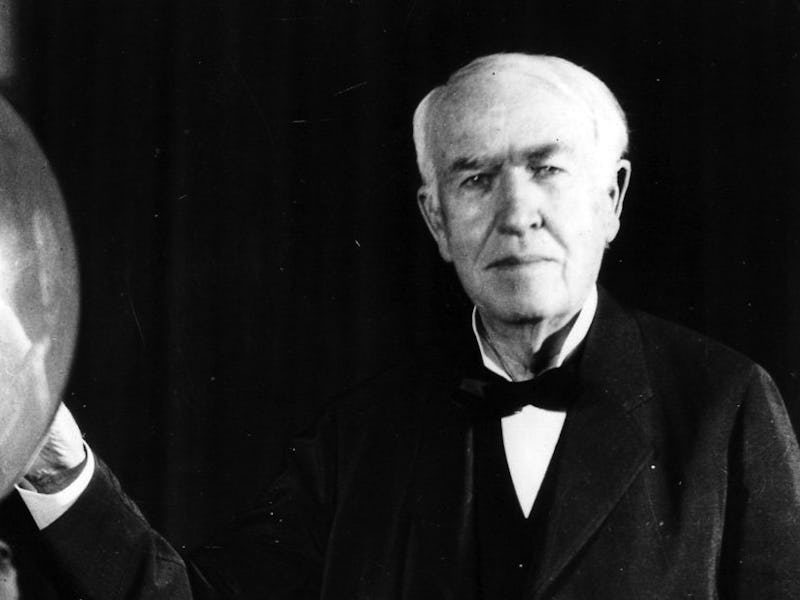Thomas Edison Couldn't Predict the Future Because His Ego Was Too Big
In a 1911 interview, Thomas Edison had some very Thomas-Edison-centric ideas about the future.

In a 1911 interview with The Miami Metropolis, Thomas Edison, who was almost certainly the then-greatest living inventor, was asked to predict what he thought the world would look like 100 years in the future. Much like his fellow genius and hated rival Nikola Tesla, the man whose inventions were responsible for shaping the 20th century proved fairly mediocre at predicting what would happen in the 21st.
Unlike Tesla, who failed to predict how interconnected the world would become, Edison’s problem was with his ego. Pretty remarkably, given his incredible import, Edison overestimated his own significance.
WHAT HE GOT WRONG
Books Made from Nickel
According to Edison, readers in the 21st century would enjoy books printed on leaves of nickel:
“A book two inches thick will contain forty thousand pages, the equivalent of a hundred volumes; six inches in aggregate thickness, it would suffice for all the contents of the Encyclopedia Britannica.”
Retrospectively, it might seem kind of strange that Edison didn’t foresee more digital delivery systems for books. However, on top of being the father of the motion picture camera, the phonograph, and telecommunications, Edison was a shrewd businessman who just happened to also be an incredibly accomplished metallurgist. Edison had already perfected (and most likely was in the process of patenting) a method of mass producing nickel leaves.
An Edison-style home in California
Steel Houses
Edison thought that steel would one day become not only be the perfect building material for residential homes, it would be used to furnish the homes as well. According to the master inventor, breakthroughs in steel manufacturing meant that it would be stronger, lighter, and more flexible than the steel available in 1911, and would be one-sixth the price.
“The baby of the twenty-first century will be rocked in a steel cradle; his father will sit in a steel chair at a steel dining table, and his mother’s boudoir will be sumptuously equipped with steel furnishings…”
Steel cribs seem like a bad idea to us too, baby,
Ever the master of self promotion, it’s probable that his penchant for steel lined boudoirs had everything to do with his substantial investment in his son’s steel manufacturing business. Luckily for babies everywhere, Edison was off on this prediction, but his view on steel was so influential, a generation of architects like Buckminster Fuller would spend decades trying to perfect steel houses.
WHAT HE GOT RIGHT
The Death of The Steam Engine
Edison quite correctly predicted that the steam engine was on it’s last leg back in 1911. He foresaw a world where trains were still a preferred method of travel, but you’ll be shocked by what he thought the 21st century locomotives method of propulsion would be!
“In the year 2011 such railway trains as survive will be driven at incredible speed by electricity (which will also be the motive force of all the world’s machinery), generated by “hydraulic” wheels.”
OK, if you know anything about Edison, you won’t be surprised at all the learn that Edison thought the trains of tomorrow would run on electricity. On top of that, he was rightly convinced that eventually, most industrial equipment would kick steam power to the curb and move over to running on electricity. Particularly on electricity created by hydroelectric power generated by one of the many Edison owned hydroelectric power stations.
The view Edison saw coming.
Transcontinental Air Travel
Less than a decade after the Wright Brothers made history at Kitty Hawk, Edison was fully convinced of the potential of air travel. In his 2011, massive luxury planes would fly incredible distances at speeds of over 200 miles an hour:
“[Man] will fly through the air, swifter than any swallow, at a speed of two hundred miles an hour, in colossal machines, which will enable him to breakfast in London, transact business in Paris and eat his luncheon in Cheapside.”
In what might be described as a rare show of modesty, Edison stopped short of proclaiming that like trains, electricity would provide the propulsion necessary to lift these “colossal machines” through the air. That being said, the last part of his life was dedicated to perfecting a nickel-iron battery, which scientists today estimate could potentially make small electric-powered passenger planes a reality.
The End of the Gold Standard
Technically, Edison was right about the end of an economy based on the gold standard, but it wasn’t due to any deep faith in fiat currency, but rather his belief that given another hundred years, mankind was sure to perfect another passion of Edison’s: alchemy.
Seriously.
Thomas Edison and the Sorcerer's Stone
Edison thought it was completely reasonable that in 2011, man should be transmuting lead into gold as easily as water poured out of a faucet:
“We are already on the verge of discovering the secret of transmuting metals, which are all substantially the same in matter, though combined in different proportions.
Not to worry, though, Edison was only proclaiming gold dead in terms of currency. Once we were turning lead into gold by the ton, Edison was all in favor of folks getting their bling on:
“In the magical days to come there is no reason why our great liners should not be of solid gold from stem to stern; why we should not ride in golden taxicabs, or substituted gold for steel in our drawing room suites.”